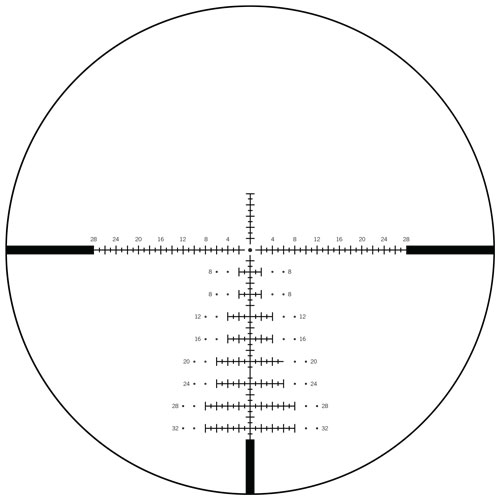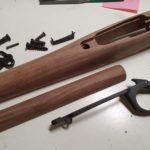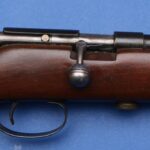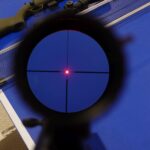When shooting 22LR at long ranges, the bullets rainbow pretty fast. Making consistent hits at long range becomes a game of gaining more and more elevation in your optics and mount.
You can use these 3 factors to extend the range of your rifle/scope combination:
- Total elevation of your scope: though usually you just get half of this since it’s describing both up and down. Most scopes will offer 50-120 MOA of adjustment range. After that, you’re bottomed out. So realistically, this gets you 25-60MOA right off the hop.
- Once you’re bottomed out, you might not be done yet. Some scopes come with reticles that have hash marks on them in MOA, MIL dots, or other. Even if you don’t have these marks on your reticle, you can use “Kentucky windage” to hold the crosshairs over the target a set amount. Kentucky windage is difficult to be precise with though. Most hashed reticles will offer hashes good for 15-35 MOA of hold over.
- To make use of more of the adjustment left in the top half of your scope, you can use a canted rail or specially designed rings like the Burris Signature rings to tilt your scope down and add on elevation. As a rule of thumb, a 20 MOA rail will give you about an extra 100 yards/meters of range with 22LR. Although the FX “No Limits” rings can offer about 144 MOA of adjustment if you want to go super far, most canted rails are in the 20-30 MOA range. There is such a thing as “too much of a good thing” with canted bases as you may cant so much that you can’t use your scope at close distance.
In 22LR, heading further than 200 yards is just outside the capabilities of some scopes. Let’s take a look at typical drop for Standard Velocity as well has High Velocity 22LR ammo. Rather than listing drop in inches, we’ll use the angular measurement of MOA because that’ll help determine what scope, base, and reticle combo’s will be successful at different ranges.
Long Range 22LR Ballistic Chart
| Range (yards) | HV (MOA) | SV (MOA) |
| 50 | 0.0 | 0.0 |
| 100 | 5.2 | 7.5 |
| 150 | 12.4 | 16.8 |
| 200 | 20.7 | 27.2 |
| 250 | 30.0 | 38.6 |
| 300 | 40.2 | 51.0 |
| 350 | 51.4 | 64.4 |
| 400 | 63.5 | 78.8 |
| 450 | 76.6 | 94.3 |
| 500 | 90.8 | 111.0 |
Scope Elevation
Generally, cheap scopes come with very little elevation adjustment available and high end long range scopes come with a lot of adjustment available. Lower magnification scopes may come with more elevation, so check the specs on your scope. Some 1-6 scopes for example, come with 150 MOA of adjustment! On the other hand, a lot of $200-$400 high magnification scopes come with pathetically low amounts of elevation travel. For example, the Burris Fullfield II 6.5-20×50 comes with only 30 MOA of total adjustment! That won’t get you very far.
Scopes that have visual indicators that tell you how many revolutions they’re at are easier to re-zero after a stage and zip up to the correct elevation.
- Inexpensive scopes with high magnification: 36 MOA
- Midrange scopes with high magnification: 50-90 MOA
- High end scopes with high magnification: 90-130 MOA
Reticle Hold Over Marks
Reticles typically come in MOA, Mil or Mil-dot, or BDC style. For extra long shots, BDC reticles can lose their utility because they are too far off from reality. While most high magnification scopes offer between 15-30 MOA of hold overs, medium magnification may offer more. When you combine your scope reticle with a ballistics program like Strelok Pro, you’ll get your hold overs.

SFP vs FFP for Long Range 22LR
With a first focal plane reticle, the reticle changes size based on the magnification to keep scale. That 2 MOA mark at 6X is still 2MOA at 24X magnification. This is very useful if you want to use your scope at a multitude of magnification settings, such as in a shooting stage where distances change drastically. So first focal plane is preferred for shooting stages that use multiple distances.
FFP is also handy for wind holdovers and swapping between multiple targets. Sometimes, max magnification is too much, so it’s nice to shoot with a scope where graduated marks work regardless the magnification.
With a second focal plane reticle, the marks only match up to their specs at one magnification setting, usually max. Incidentally, you could use this trick to get more elevation on the cheap by shooting at less than full magnification. The 30 MOA holdover mark on a 14X scope becomes a 60 MOA holdover at 7X. Neat trick, but your magnification setting needs to be bang on for this to work and that can be hard to do. Second focal plane scopes are usually cheaper than first focal plane scopes.
Rails and Rings
Most scopes out there will benefit from at least a 20 MOA rail, but there are some exceptions. The Bushnell Banner 6-24×50 only has 36 MOA of adjustment, so you may run run out of elevation just zeroing the scope at closer ranges. Rifles like the Ruger Precision Rimfire come with a 30 MOA rail so you’re ready to shoot long range 22LR out of the box.
EGW sells a ton of canted bases for a variety of rimfire rifles. You can also run a standard weaver base or rail, and then use some Burris Signature Zee Rings with their plastic shims to get more elevation.
DIY 22LR Canted Bases with Shims
You can get some cant in your rimfire base by adding materials between the rear of the base and the receiver. Generally, 0.001 delivers 1 MOA, or 0.02″ for 20MOA. This can be tough with rimfire dovetail bases where the base may not grab onto the receiver rail very good if you jack them up 20 thou.
Some guys report success putting .020″ shims between their rear ring and scope or under the rear ring to get a quick 20 MOA. Others say that this is blasphemy and you’ll torque your scope when you tighten your rings if you do it this way.
My Example: NS522 with a Sightron 6-24 and Burris Signature Zee Rings
My Sightron 6-24×50 FFP has 80 MOA of elevation adjustment, 20 MOA on the reticle hold over marks, and my Burris Signature Zee rings offer 27 MOA of extra elevation at the setting and spacing I currently have them at.
40 MOA on the scope, 20 on the reticle hold overs, and 27 on the rings gives me 87 MOA of vertical adjustment from zero: good for 400 yards with SV ammo or about 475 yards with HV ammo.









